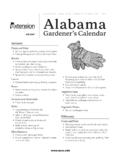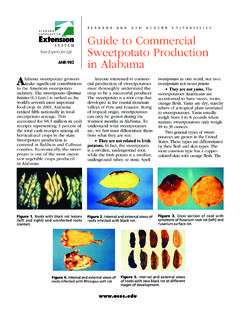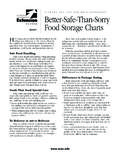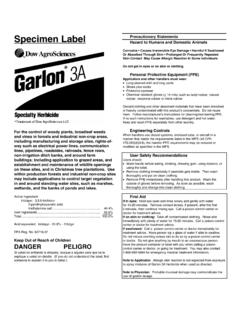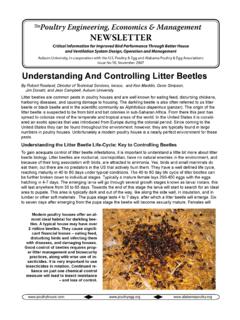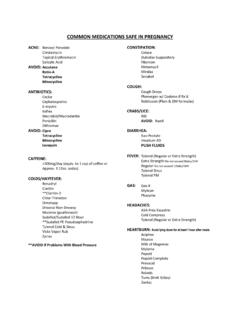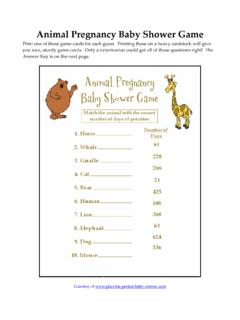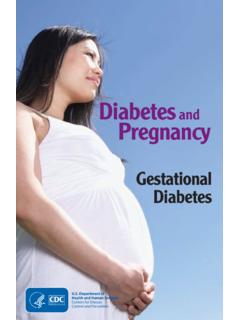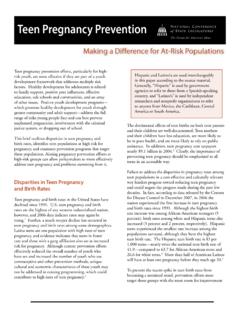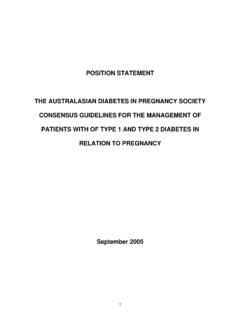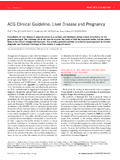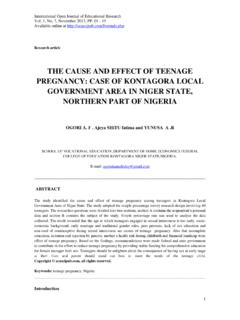Transcription of Pregnancy Toxemia (Ketosis) in Goats
1 ALABAMA A&M AND AUBURN UNIVERSITIES. Pregnancy Toxemia ( ketosis ). UNP-106 in Goats Introduction Signs Pregnancy Toxemia is a metabolic disorder that Pregnancy Toxemia occurs frequently within 1. occurs in does during the late stage of to 3 weeks from kidding, and it is associated gestation. Does that have low energy levels are with prepartum mortality in a doe herd. The more susceptible to Toxemia . This low energy first signs of Pregnancy Toxemia are: level is caused by a sudden increase in nutritional demands as a result of rapid fetus Little or no appetite development. Under these conditions, the doe's Depression body is depleted of carbohydrates that are used Lethargy or sluggishness to produce glucose or sugar.
2 When this Muscular imbalance or poor coordination, condition occurs, rumen capacity decreases as known as ataxia the uterus expands to handle the growth of one Grinding of teeth or more fetuses. Blindness Pregnancy Toxemia can occur in young and old Does become so weak they are forced to lie does with good or poor body condition. Studies down and, in most cases, will not be able to have shown, however, susceptibility to rise again; legs are usually tucked underneath Pregnancy Toxemia to be higher in older, fatty the body. They also have sweet or foul- animals carrying multiple fetuses. smelling breath when there is a high level of ketones or toxins in the blood.
3 These During Pregnancy , the doe's body resorts to symptoms may occur within a few hours to 2. another source of energy when carbohydrates days from the onset of signs. If symptoms are in low supply. This alternative source persist, does could progress to coma or even involves the production of glucose from other death. A doe's death is attributed to reduced noncarbohydrate substances to facilitate liver and kidney function. When the doe dies, glucose availability to the fetuses. These events the fetus or fetuses also die. However, if a often coincide with the beginning of milk fetus dies and is not removed quickly, production. During late gestation, an average of septicemia will occur, carrying the pathogen 30 to 40 grams of glucose a day per fetus is throughout the doe's bloodstream.
4 Required to meet metabolic demand. If the doe's body does not meet this demand, its body will store use fat as an energy source. This Diagnosis mechanism of breaking down stored fats will consequently overwhelm the liver's capacity, For an accurate diagnosis of Pregnancy result in hepatic lipidosis or fatty liver, and Toxemia , a differential diagnosis is important to ultimately, impair liver function. As the doe's determine this metabolic disorder from other body progresses in mobilizing more body fatty disorders with similar signs such as hypoc- tissue, it will produce highly toxic byproducts or alcemia or hypomagnesemia, resulting from low ketone bodies that are released into the blood calcium or magnesium levels in the blood.
5 Circulation, causing an increase in hepatic fat Other disorders with similar symptoms include accumulation. diseases that affect the nervous system such as polioencephalomalacia, enterotoxemia, rabies, listeriosis, and lead poisoning. When possible, a quick laboratory analysis is important to diagnose and treat Pregnancy Toxemia . As with many diseases, a prompt diagnosis If possible, consider an ultrasound to and proper care leads to successful treatment. determine the number of viable fetus(es). A clinical diagnosis is fundamental and the doe is carrying. consists of the histories of the animal and herd, the identification of the clinical signs, Consider the induction of labor in a doe that and detection of high levels of ketone bodies is near term or parturition using 15 to 20.
6 In the urine. Ketone bodies can be determined mg dexamethasone intravenously or by using commercial, quantitative tests ( , intramuscularly. Consult your local Ketostick). Prognosis is given by the levels of veterinarian if a Cesarean section is needed. acidosis, dehydration, and hepatic and renal failure that occur. In the case of fetal death, a fetotomy, which is the removal of fetal tissues and placenta, At necropsy, does present fatty infiltration of is recommended, followed by the the liver, enlargement of adrenal glands, and administration of an antibiotic such as atrophy of the kidneys. procaine penicillin G at 20,000 IU/kg, to prevent infection.
7 When available, laboratory analyses can be useful tools for diagnosis; however, Consider the administration of vitamin B. producers must be mindful of associated complex intramuscularly and probiotics costs. In most cases of Pregnancy Toxemia , orally. the levels of glucose in the blood are normal, and some affected does have shown Treatment should be discontinued when the doe hyperglycemia (higher levels of glucose in presents signs of improvement. the blood). Thus, the levels of glucose in the blood are not a good indicator for the diagnosis of Pregnancy Toxemia . Prevention A good feeding management practice is needed Treatment at the late stage of Pregnancy .
8 During the last 6. weeks of gestation, provide grain as it is an The success of the treatment depends upon the essential source of carbohydrates. Does carrying diagnosis of Pregnancy Toxemia in its early multiple fetuses should be fed adequate energy- stages. Does can be successfully treated with TDN levels (Tables 1 and 2). Producers should 60 to 90 ml of propylene glycol administered be mindful that the levels of energy in the diet orally 2 to 3 times per day, along with the might vary depending on forage quality and administration of insulin. Administer 20 to 40 availability, doe body weight and condition IU protamine zinc insulin intramuscularly every score, and the number of fetuses the doe is other day to help restore glucose uptake.
9 Carrying. It is important to balance the levels of protein in the concentrate because protein must Administering electrolyte solutions be available for ruminal microbial function. The containing 5 percent dextrose orally, primary sources of energy found in forages are intravenously, or subcutaneously is also the large and complex carbohydrate molecules, recommended. cellulose, hemicelluloses, and pectin. The doe's body cannot digest these components of the If the doe is in a comatose state, the treatment forages, but the rumen microbial population is frequently costly and prognosis is poor. can. The bacteria and protozoa of the rumen Treatment methods include: will degrade cellulose and hemi-cellulose and, consequently, supply energy to the doe.
10 Administer orally propylene glycol, 4. ounces/4 times a day. Alternatively, Nutri- Consider supplying concentrated rations with Drench can be substituted for propylene ionophores. Ionophores increase the ruminal glycol. Administration of sodium utilization of volatile fatty acid propionic acid, bicarbonate solution intravenously or orally which, in turn, will be used in the production of is also used to treat ketoacidosis. energy. Also, avoid stress and sudden dietary changes at late Pregnancy . 2 Alabama Cooperative Extension System NOTE: Some products mentioned in this article are considered extra-label products for use in meat and dairy Goats . Consult a veterinarian before using extra-label products and for disease treatment and prevention.
